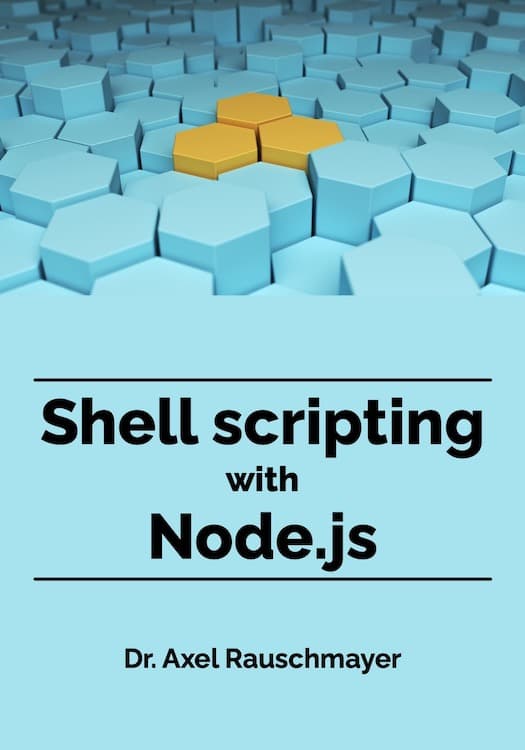[Web dev for beginners] Numbers, variables, functions in JavaScript
This blog post is part of the series “Web development for beginners” – which teaches people who have never programmed how to create web apps with JavaScript.
I’m interested in feedback! If there is something you don’t understand, please write a comment at the end of this page.
In this chapter, we take the very first steps with JavaScript and learn about numbers, variables and functions.
Starting with the next chapter, we’ll always learn by creating real, useful apps. In this chapter, we’ll warm up by doing some relatively simple interactions with JavaScript.
Browser consoles
To run JavaScript programs, we need a so-called JavaScript engine. Luckily, each web browser has a built-in JavaScript engine. One way of interacting with it is via the browser’s console (think JavaScript shell). We’ll see soon how the console works. As a first step, please figure out how to open the console of the web browser that you are using. The following links may help:
- Opening the console in Google Chrome (should also work work Microsoft Edge)
- Enabling the “Developer” menu in Safari. That menu has the command “Show JavaScript Console”.
- Opening the console in Firefox.
As an aside: I will occasionally ask you to figure out things by yourself (by doing a web search etc.). That is an important skill for web developers: You will not always have someone who explains to you how to do something. You will have to do your own research, experiment, etc.
How does the console work?
The console enables an infinite back and forth between us and JavaScript:
- We provide JavaScript with input in the form of JavaScript code.
- The web browser displays a result – the corresponding output.
Let’s try out the console.
Numbers: JavaScript as a calculator
We’ll start with very simple JavaScript code: so-called numeric expressions – “formulas” with numbers. For example, JavaScript can add numbers:
- Input (typed by us):
3 + 2 - Output (shown by the browser):
5
You can follow along in your own browser console and see if your output always matches what is shown here.
From now on, console interactions will be displayed as follows:
> 3 + 2
5
The > (greater-than symbol) at the beginning of the first line indicates that this is our input. It represents the prompt of the console and is not typed by us. We type what comes after the >. The second line is the browser’s output.
Operators and operands
So far, we have used the addition operator + to add numbers. The values at its left-hand side and its right-hand side are called its operands – e.g.:
3 + 2
Here, + is an operator and 3 and 2 are its operands.
More operators for numbers
JavaScript has more operators for numbers – these are a few examples:
-
Use the subtraction operator
-to subtract numbers (the symbol is a hyphen):> 3 - 2 1 -
Use the multiplication operator
*to multiply numbers (the symbol is an asterisk):> 3 * 2 6 -
Use the division operator
/to divide numbers (the symbol is a slash):> 3 / 2 1.5
Note that we have seen two kinds of numbers:
- Integer numbers such as
5 - Floating point numbers such as
1.5. As a rough rule of thumb, “floating point number” means a number that has a decimal point (that “floats” inside an integer). Wikipedia has more information, if you are curious.
Internally, JavaScript does not distinguish between the floating point number 5.0 and the integer 5. To JavaScript, both are simply numbers.
Longer numeric expressions
We can also write longer numeric expressions:
> 1 + 2 * 3
7
However, given that it’s not immediately obvious in which order multiple operators are going to be applied, I prefer to use parentheses in such a case – they make it clear what’s going to happen:
-
Adding 1 to 2 times 3:
> 1 + (2 * 3) 7 -
Multiplying 1 plus 2 by 3:
> (1 + 2) * 3 9
JavaScript does the former – it follows the mathematical rule of multiplication (and division) having a higher precedence than addition (and subtraction).
How is JavaScript code executed?
If we want to run a JavaScript program, we need a JavaScript engine:
- We feed that engine JavaScript source code. Source code is always text and often stored in text files.
- This code contains instructions that tell the engine what to do.
- The engine follows those instructions and things happen inside the engine.
In general, the JavaScript engine is a black box: We don’t see what happens inside it. However, there are exceptions – e.g.:
- A browser console extracts and displays a result after instructions are executed.
- Some instructions can cause something to happen in the world outside the engine – e.g., elsewhere in the web browser.
There are two words related to running JavaScript which are useful to know:
-
Syntax: Syntax refers to the rules for writing correct JavaScript programs. Computer languages are similar to human languages when it comes to syntax:
- Syntactically incorrect English sentence: Me am Superman.
- Syntactically incorrect JavaScript expression:
+ 3 1
Syntax can additionally refer to the structure of JavaScript source code (vs. the rules for that structure).
-
Runtime: The time during which an engine runs JavaScript code is called runtime.
Variables
Variables are an important construct in JavaScript: A variable is a box with a name in which we can put values (such as numbers).
> let myNumber = 8;
undefined
> myNumber * 2
16
- In the first line, we create the variable
myNumber. We’ll soon get answers to two questions:- How exactly does that syntax work?
- What does the result
undefinedmean?
- In the third line, we use the variable:
myNumberhas become a name (an alias, an abbreviation) for the value that the variable contains.
So far, we have only seen one kind of JavaScript code: expressions. An expression is JavaScript syntax that, when run, produces a value. The previous interaction contains new syntax:
let myNumber = 8;
That is a statement: syntax that, when executed, does things (at runtime). This particular statement is a variable declaration. It creates a variable. Let’s examine the syntax:
letis the name of one command for creating variables.myNumberis the name of the created variable.- The equals sign (
=) indicates that we want to specify an initial value for the variable.8is that initial value. We initializedmyNumberwith8. - The semicolon is used to mark the end of a statement. It can often be omitted.
Why does this statement produce the result undefined? That is a pseudo-value that means “there is no real result”. Statements often don’t have results. Expressions always have results.
Rules for variable names
- First character: a letter (
A,b, etc.), a dollar sign ($) or an underscore (_) - Subsequent characters: all characters that are allowed as first characters plus digits (
3,0, etc.).
The names of most variables start with lowercase letters. Word boundaries are marked via capital letters:
numberOfPeoplevalue3
This way of writing variable names is called camel case (because it has humps – like a camel).
Variables whose values never change sometimes have names with words in all-caps, separated by underscores:
NUMBER_OF_PEOPLEVALUE3
The results of statements virtually never matter in normal code
The result of statement is virtually never useful. Therefore, from now on, I will omit the result of a console input if it ends with a semicolon – i.e., I’d write the previous example like this:
> let myNumber = 8;
> myNumber * 2
16
The output of the first line is irrelevant and therefore omitted.
Syntax errors
If we don’t follow the syntax rules then JavaScript reports an error and we can’t run the code – e.g., let’s use an illegal variable name that starts with a digit:
> let 1number = 7;
SyntaxError: Invalid or unexpected token
The exact message varies between JavaScript engines, but the name of the error is always SyntaxError.
Assigning to variables
In addition to retrieving the content of a variable, we can also change its content:
> let value = 0;
> value
0
> value = 3;
> value
3
We initialized the variable value with 0. Later, we changed its value to 3. We used the assignment operator (=) to do so (this time without a let).
The right-hand side of an assignment can be any expression:
> value = 1 + 1 + 1;
> value
3
That enables statements that look weird and unmathematical:
> let myVar = 0;
> myVar = myVar + 1;
> myVar
1
What does the following statement mean?
myVar = myVar + 1;
- Step 1: retrieve the value of
myVar. - Step 2: add
1to it. - Step 3: store the result inside
myVar.
In other words: The assignment operator is not a mathematical equals sign. Its syntax has historical reasons. This would be better syntax:
myVar <- myVar + 1;
Constants (immutable variables)
If we never change the value of a variable, we can use a different way of declaring it. Then JavaScript warns us if we accidentally change it:
> const TWO = 2;
> TWO + TWO
4
> TWO = 3;
TypeError: Assignment to constant variable.
In JavaScript, const is not much different from let. Its most useful as hint for programmers: “This variable will never change.”
The name of the variable is written in capital letters – as an additional hint that it is a constant. But we don’t have to do that; in fact, doing that has even become somewhat rare.
Functions
So far, the only values we have seen were numbers. Let’s explore another kind of value next: functions. A function is like a little program that we store inside a variable. We can use a statement to run/call/invoke a function:
- It gets zero or more values as input.
- It produces/returns one values as a result.
In the following example, the variable timesThree is/contains a function:
> const timesThree = (x) => { return x * 3; };
> timesThree(2)
6
> timesThree(0.5)
1.5
- In line 1, we create the function
timesThree. - In line 2, we call the function with the value
2. It returns the result6.
The function as a value has the following syntax:
(x) => { return x * 3; }
What does this syntax mean?
(x): The input of the function is stored in the variablex. This variable is called the parameter of the function. A function can have zero or more parameters.- The rest of the syntax specifies the code of the function (its body):
- The arrow
=>is mostly decorative. - The curly braces (
{and}) contain the function’s code. Curly braces with statements are also called code blocks.
- The arrow
The body of a function can contain zero or more statements. The return statement specifies the result of calling the function. I often omit the semicolon when it is immediately followed by a closing brace. In this case, I didn’t.
This syntax for creating a function is called an arrow function. The name comes from the arrow (=>). We’ll learn another syntax for creating functions in a future chapter.
Parameters vs. arguments
In consoles, our JavaScript code usually only consists of a single line. However, JavaScript code is normally stored in text files and consists of multiple lines. Since JavaScript mostly ignores line breaks (“newlines”), we can insert them as we see fit – in order to make the JavaScript code easier to read for humans. (As an aside, we could also write a while program as a single line of code but that would be quite inconvenient for us.)
The following code is an example of a function that spans multiple lines of text:
const add = (x, y) => { // (A)
return x + y;
};
const result = add(2, 3); // (B)
// `result` is 5
Let’s use this function to introduce the new term argument. The term parameter and the term argument are often used interchangeably. But we can make a distinction:
xandyare parameters of the functionadd(line A).2and3are arguments of the function call in line B.
Example: converting a temperature from Celsius to Fahrenheit
The following function converts a temperature in Fahrenheit to a temperature in Celsius (source: Wikipedia):
const celsiusToFahrenheit = (c) => {
const f = (c * (9/5)) + 32;
return f;
};
Explanations:
- The parameter
cis the input: A number that specifies the temperature in degree Celsius. - We convert that value to degree Fahrenheit and store it in the constant variable
f. For clarity, we have used more parentheses than strictly necessary. - Finally, we return
fas the result of the function.
Note that the function contains two statements. Each ends with a semicolon. The semicolon at the very end belongs to the const:
const celsiusToFahrenheit = ···;
We can paste this multi-line code into a console and call the function:
> celsiusToFahrenheit(0)
32
> celsiusToFahrenheit(40)
104
We’ll see this function again in a future project!
Exercises (without solutions)
- Perform some numeric computations in a browser console.
- Write a function
fahrenheitToCelsiusand ensure that it works properly by checking a few results of function calls.





